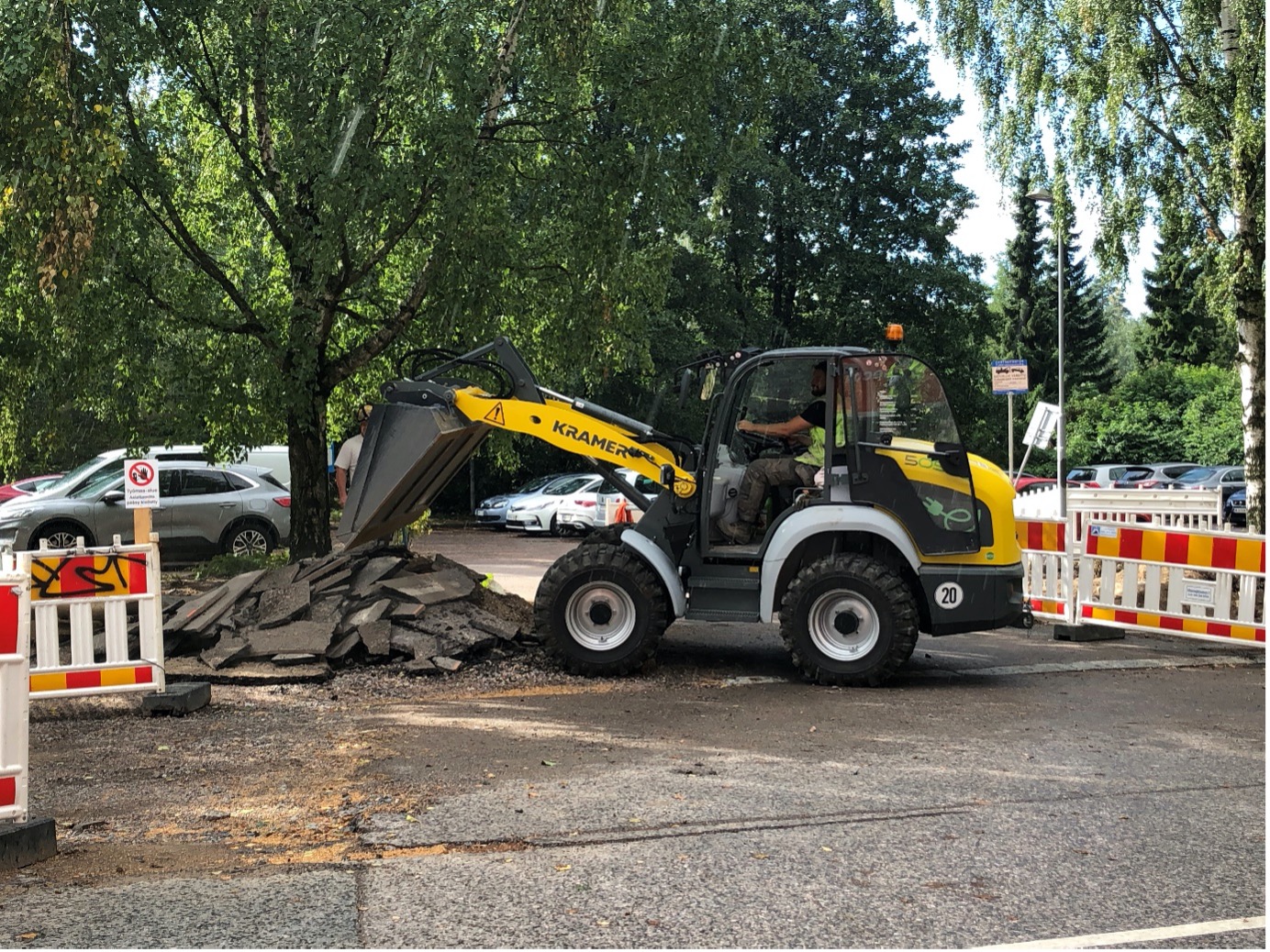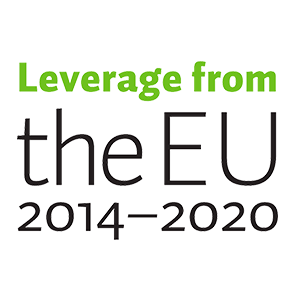
How can we reduce emissions from infrastructure construction sites?

Pilot for a zero-emission infrastructure worksite in Helsinki: turning Kulosaaren puistotie into a cycling street
- low-emission
- construction site
- heavy machinery
- heavy goods vehicle
- fossil-free
- renewable HVO diesel
- alternative motive power solutions
- electric heavy machinery and equipment
- market dialogue
- emission-free construction sites – green deal agreement for sustainable procurement
Construction sites not only cause significant amounts of greenhouse gas emissions but also harmful local emissions. The boulevard of Kulosaaren puistotie was one of the pilot sites in the emission-free infrastructure construction sites project of the City of Helsinki. The objective of these pilot sites was to reduce emissions from construction sites. The machinery and equipment used on the site included four fully electric heavy machinery units, while the rest of the machinery was powered by renewable HVO diesel.
- Electric heavy machinery and equipment. Companies participating in the tender were urged to use electric heavy machinery and equipment. Three fully electric loaders and one mini excavator were used on the site. While in operation, they do not generate emissions or make a lot of noise.
- Positive experiences. Since the summer of 2020, all tendered infrastructure construction sites of the City of Helsinki have been based on low-emission solutions. So far, it seems that having low-emission criteria in the requirements has had very little impact on companies’ motivation to participate in tenders or their pricing.
- 58% less emissions. Thanks to the solutions, emissions from the pilot project were only about 42% of those from a traditional construction site, and the solutions prevented the generation of over 106 tonnes of CO2 equivalent.
This solution is right for you if
- you buy infrastructure construction services;
- you represent an infrastructure company/contractor; or
- you want to reduce emissions from your organisation’s construction sites.
BASIC FACTS
- Location: Helsinki, Kulosaari – the boulevard of Kulosaaren puistotie was converted into a shared in-roadway bikeway, becoming part of the Itäbaana express bike route, one of the main bike routes to the city centre
- Time frame: 12/2019 (dialogue with the market) – 4/2021 (project completion)
- Project parties: City of Helsinki, Urban Environment Division, Housing and Environment; contractor: VM Suomalainen Oy
A carbon-neutral Helsinki can only be achieved by also reducing emissions from construction sites
Emissions from heavy machinery and equipment used on construction sites as well as heavy goods vehicles account for a significant proportion of carbon dioxide emissions generated in cities and municipalities. Moreover, they also generate harmful local emissions, particles and noise that impair air quality in the area. In densely built urban environments, the harmful effects of construction sites are even greater.
Despite this backdrop, current legislation does not give decision-makers enough power to address construction sites’ harmful effects on climate and health, and greenhouse gas emissions caused by heavy machinery and equipment are not regulated. The City of Helsinki has recognised this issue, and one of the goals of the Carbon-neutral Helsinki 2035 Action Plan is to reduce greenhouse gas emissions from construction sites with initiatives such as piloting the use of emission-free heavy machinery and equipment in the City’s infrastructure projects.
The City of Helsinki has also actively participated in international campaigns and projects to promote emission-free construction sites. European cities have exchanged information and experiences for example in the Zero-Emission Construction Sites working group of the Big Buyers Initiative funded by the European Commission and in the E-ZEMCONS project funded by EIT Climate-KIC.
Engaging in market dialogue to ensure a successful tender process
The City of Helsinki launched the market dialogue on zero-emission infrastructure construction sites and the preparation of the procurement criteria in December 2019. A joint market dialogue event with the stakeholders was followed by one-to-one discussions with several infrastructure contractors. Market representatives provided valuable information about aspects such as the current condition of the fleet and the availability of electric heavy machinery and equipment, and they also confirmed the use of the proposed minimum requirements.
Spring 2020 saw the finalisation of the criteria to be used in the tender and, more widely, in the zero-emission construction site pilot project and on low-emission infrastructure construction sites. The invitation to tender for the pilot project of the boulevard of Kulosaaren puistotie was published in May 2020.
Contract documentation was being drawn up at the same time with the preparation of the green feal agreement for emission-free construction Sites. The requirements laid down in the invitations to tender for the City of Helsinki’s infrastructure contracts are more ambitious than the current requirements of the green deal agreement, which defines a joint minimum level, while cities have the option to impose stricter criteria at a faster pace.
Trialling zero-emission solutions on the construction site of the boulevard of Kulosaaren puistotie
Launched in July 2020, the conversion of the boulevard of Kulosaaren puistotie into a shared cycle lane is a pilot project in which greenhouse gas emissions and harmful local emissions generated on the site were reduced using concrete methods. The equipment fleet used on the site consisted of four fully electric heavy machinery units (three 4.2-tonne loaders and one mini excavator), while the rest of the equipment, apart from a few exceptions, was powered by renewable HVO diesel.
The other fossil-free fuels allowed to be used on the site were biogas, hydrogen, ethanol and renewable fuel oil. The heavy machinery was at least Stage IV compliant, while heavy goods vehicles were compliant with the Euro VI emission standards. Light equipment (equipment with a maximum power of 4 kW) was required to be primarily powered by electricity. The electricity used on the site was required to be produced from renewable energy sources, and heating on the site had to be based on district heating, fossil-free biofuels or green electricity. In addition, the contractor was required to have obtained environmental certification. The use of electric heavy machinery and equipment was encouraged by awarding the most economically advantageous quality scores (in which the price accounts for 70% and quality for 30%) for a maximum of five electric heavy machinery units.
The list of equipment used in the project was updated whenever new machinery and equipment was brought to the site. The consumption of fuel and electricity on the site was reported monthly in site meetings. The customer and contractor developed monitoring and reporting together.
Positive experiences pave the way for future projects
When the majority of the Kulosaari project had been completed, the HNRY project team produced a rough calculation of the emissions generated during the project compared to a project based on traditional solutions. The calculation was based on fuel and electricity consumption and equipment uptime data obtained from the contractor. The calculation showed that, thanks to the solutions used on the site, the emissions from the site were about 42% of the emissions of a similar project carried out using traditional solutions. The amount of emissions that were prevented was over 106 tonnes of CO2 equivalent, or the annual carbon footprint of roughly ten people living in Finland.
Principles of zero- and low-emission construction sites have already been utilised on several infrastructure construction sites of the City of Helsinki. Encouraged by the success of the pilot projects, all tendered infrastructure construction sites of the City of Helsinki have been based on low-emission solutions since the summer of 2020. The experiences have primarily been positive, and it seems that having low-emission criteria in the requirements has had very little impact on companies’ motivation to participate in tenders or their pricing. In 2021, the City of Helsinki aims to apply the principles of zero-emission constructions sites compliant with the Green Deal agreement to all of its tendered infrastructure, construction and maintenance projects.
TAKE-HOME MESSAGES
- Engaging stakeholder groups and active market dialogue are focal points for formulating functional and suitably ambitious purchasing criteria.
- The ambition of the City of Helsinki to cut down the emission levels is shared within the infrastructure companies and the goals are to be realized through the procument requirements.
- Different types of collaboration platforms are recommendable for sharing the experiences and lessons learnt.
- Having an open mind is worthwhile – you learn by doing and the pace of development might surprise.
“Contractors’ ability to meet low- and zero-emission requirements seems to be improving quickly, so reducing emissions from construction sites in line with the green deal agreement seems like a realistic goal.”
– Jarkko Karttunen, Head of the Urban Environment Division, City of Helsinki
“The Kulosaari project got me thinking about how, by making small changes, you can get the same output but with less emissions. We are already using renewable electricity throughout the company. There are plenty of great and competitively powered and priced low-emission products and services available in Finland, but due to the prejudice against these solutions, there is still lots that needs to be done, in particular when it comes to people’s ideas about quality.”
– Tim Karike, Communications Manager, VM Suomalainen Oy






 (in Finnish) Helsingin vähäpäästöiset työmaapilotit ovat käynnistyneet
(in Finnish) Helsingin vähäpäästöiset työmaapilotit ovat käynnistyneet